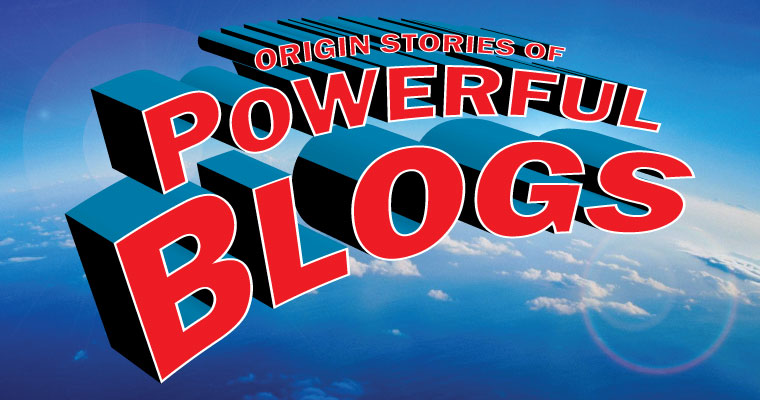I’m always interested in how blogs that seem to get tons of traffic and shares every time they hit publish got their start. If you’re toiling in obscurity (which is the case for a vast majority of company and personal blogs) you’re likely more interested in how a blog went from zero to prominent and profitable than you are in learning all the tips and tricks that the rich use to get even richer.
Towards that end, this is the first post in a series of interviews with people who were involved in the early stages of what are now powerful blogs that have large readerships and get lots of traffic and shares. The focus of these interviews is to find out what these powerful blogs did at the beginning to get where they are now: What mistakes did they make? What worked well right off the bat? What would they do differently knowing what they know now, and what would they absolutely not change?

The subject of this interview is Elisa Gabbert. Elisa is the SEO and Content Marketing Manager at WordStream Inc. She has been at WordStream for six years, managing the company’s popular blog, which covers internet marketing topics including paid search advertising, content marketing, conversation rate optimization, social media and more, as well as driving WordStream’s overall content strategy. She is also a poet and essayist.
I was an early employee at WordStream and got to work closely with Elisa in the company’s formative days. In recent years I’ve watched the WordStream blog really explode and become a top PPC and marketing blog by most metrics and on most lists, while helping to position my former boss Larry Kim as the most influential PPC marketer around. I asked Elisa a series of questions about the beginnings of the WordStream blog, and she shared some great info below.
1. Are there any metrics or general measures of success for the blog you can share?
We aim for a sort of uber-metric that we call, internally, “the awesomeness metric.” It’s relative rather than absolute – as our blog grows, the baseline metrics keep getting bigger – but it’s a mash-up of a bunch of engagement metrics that we consider important: traffic, social shares, links, comments, newsletter signups, and other conversions. Sometimes certain posts do better in one area than others (a lot of traffic but not a lot of conversions, for example), but the most awesome posts do well across all of the metrics. It would be impossible for every post to be awesome (80/20 rule says some posts will always outperform others) so we aim for one to two awesome posts per week, and about one super-awesome post per month. Our most “awesome” post in March kind of blew our previous metrics away – it got over 100,000 visits and about the same number of shares. (Crazy!) We do have other posts that drive 20 to 30k visits every month, thanks to strong SEO for evergreen keywords.
2. What was the main objective for the blog when you started it?
You were actually in charge of marketing when we started the blog (thanks Tom), but I gathered that the purpose was mainly to accomplish three things:
- Build links (…with high-quality, evergreen how-to articles such as the ones Ken Lyons used to write – we still get quite a bit of traffic for “How to Find Anyone’s Email Address”)
- Build organic traffic (I learned keyword targeting from the best!)
- Foster industry connections (by linking out, sharing our peers’ news and content, interviewing them, etc.)
I would say all of this is still true, but we’ve gotten better and better at it over time. We have more people writing for us, so we not only publish more frequently, but we reject all but the best guest posts. We really try to create content that people will want to amplify – it’s not enough just to rank and get clicks if people won’t want to share that content. We want to be seen as thought leaders in our space, a brand that makes news and doesn’t just parrot it back.
3. Roughly how much time was your team spending on the blog early on?
Early on, it was maybe 20% of Ken’s time and 10-20% of mine. We published one to two blog posts per week, and they were often very short and self-promotional. Now, I probably spend 70% or more of my time managing the blog, including managing a couple of full-time content producers as well as some part-time writers. We also have a full-time social media and PR manager who spends most of her time promoting our blog content and other thought leadership. And, of course, Larry devotes a lot of his time to blogging as well. Now we usually publish five to seven new blog posts per week, many of which are long-form guides with word counts of 2,000 or more and lots of images. We leverage proprietary internal data whenever possible. We take it very seriously!
4. What was your plan or strategy for the blog? Did you have a specific game plan or editorial calendar, just start hitting publish, or something in-between?
Initially it was pretty scattered, though we did publish an industry round-up post every Friday for several years. (We don’t publish these anymore.) In the early days, I tried to create and enforce an editorial calendar, but nobody stuck to it and it ended up being a waste of time! Now that we have so many more writing resources to lean on, I do maintain a working editorial calendar, with content planned out up to t weeks in advance. I don’t like to plan out any further than that though – I like to keep the schedule flexible/agile/responsive.
5. How did you come up with topics for the blog early on?
Our blog topics have always been driven by keyword research. I still think this is the absolute best way to ensure that you’ll have an audience for your blog content. We also scan the news regularly and try to provide our own commentary on big industry stories. People have come to look to us for our take on AdWords and Google announcements in particular.
6. How long was the content you created early on?
I would say the early posts were usually 500 to 750 words, with some exceptions. Our average post has gotten a lot longer – we’ve found that, counter to the old established wisdom about people not wanting to read long content on the web, our longer-form, more in-depth content gets better engagement across the board.
7. How frequently did you publish new content?
As mentioned above, around twice a week. That gradually increased, but I have no plans to do more than one post per weekday on average. I’d rather focus on keeping quality and originality high than increasing quantity beyond where we’re at.
8. What content types did you use most frequently (really in-depth articles, shorter news posts, infographics, interviews, etc.) that really worked?
We definitely tried all those types of content early on. Infographics performed really well for us in the early years, but they’ve had diminishing returns since. (We do have a couple of evergreen infographics that still perform very well, but new ones haven’t caught on as much, so I shy away from creating them these days, mostly preferring smaller/simpler linkable assets.) Long articles targeted to evergreen keywords were also hits. Interviews were a good way to establish industry connections, but unless they were big group interviews, they didn’t tend to perform really well. News posts have always been hit or miss – if you get the timing just right, you can really strike gold that way, since almost everyone who covers the story will end up linking to you. It helps if you provide an interesting angle on the news as opposed to doing straight reporting. But by definition, those posts go out of date quickly.
9. What did you use as KPIs (if any) early on to determine if you were getting traction or if the blog was accomplishing what you wanted it to?
Certainly evergreen traffic and links – we used to go after links much more directly. Everyone did in those days! (If they knew what they were doing, at least.) Infographics were definitely a form of “linkbait” – we would even have the target publications in mind when we conceived the concept. Though we still view inbound links as a sign of success, we don’t have to work so hard for them these days. They pretty much build themselves.
10. What content types (if any) from the early days of the blog did you retire quickly because they didn’t work?
As I mentioned above, we stopped doing the Friday round-ups. They served their purpose, but rarely performed as well as other types of posts – partially because Friday can be a slow day, partially because they weren’t keyword-targeted so they didn’t get much if any organic traffic after the first week they went up. We’ve also stopped publishing the kinds of how-to posts that you could basically get in the same form from the AdWords documentation. We always try to provide our own “spin” on any topic – otherwise, why would people come to us for that information instead of getting it somewhere else?
11. What content (if any) worked really well for your goals early on but was something you moved away from? Why did you stop producing it, and would you still recommend it for a new blog?
Anything that has become a really overused tactic in the industry is something I shy away from now. Group interviews are a great example – for a while I was getting emails almost every week to participate in some group interview with 75 other “experts.” I got so tired of seeing these hastily thrown together, ridiculously long posts that I stopped answering, stopped clicking on them in my feed, etc. When I do host a group interview, I make sure it’s a small, focused group of people I personally really respect as experts. (The last one I did was in early 2014, an interview on the future of links and PageRank.)
12. How did you promote your content early on (social, outreach, other means)? Did you or someone involved with the blog have an established following or were you starting from scratch?
We pretty much started from scratch! Luckily you and Ken made lots of connections early on that helped us build an audience. We leveraged Twitter and an email list for promotion and also did outreach as necessary. These days, our email list has gotten exponentially bigger, and we’ve also gotten a lot more savvy with social promotion, including some paid promotion, and content remarketing.
13. Did you ever think about quitting or pausing the blog, or limiting your investment in it?
No way. It’s always been central to our brand and business model, and it’s only gotten more important over time.
14. How long was it before you felt like the blog really got “traction” and started to pay serious dividends for you and your business (new clients, more sales, more partnership opportunities, etc.)? What do you think was most responsible for reaching that inflection point?
I wouldn’t say there was a clear point where it took off. This graph shows growth as a percentage of total site traffic over the past five years:

You can see that the blog, initially, was a pretty small percentage of overall site traffic; around 2013 it started to account for a much larger proportion of site growth. But overall, it was a slow and steady progression. Our blog traffic has grown by about 100% every year for the past few years.
However, if I did have to name a certain point, it would have to be when we published this infographic on the top 20 most expensive keywords in AdWords in 2011. It was based on our own internal keyword research, drove a huge spike of traffic and links, won us a lot of PR and subsequent leads/sales, and continues to be a top content piece. I think that’s when we really started to embrace the power of content as a company.
15. If you had to start over knowing what you know now, what would you do differently? Is there any one thing you really cringe at looking back (and/or something you cringe at when you see people making the same mistake)? What advice would you give the version of yourself that was about to start the blog?
We published some really spammy crap early on, and yes, it makes me cringe. I’ve deleted some of it. Basically if some Joe Schmo with a link building tool wanted us to review his software, we’d review it and include plenty of anchor-text-rich links for him to boot, probably with the understanding that they’d return the favor. I’m a lot more careful now about who we’ll link out to. Knowing that links are on high alert at Google now, I’d advise beginning blogs to be pretty careful about their link-building tactics. If you focus on other kinds of engagement instead (like creating content that people want to bookmark and share), links tend to come with the territory.
16. If you had to start over, what would you absolutely not change that you did early on?
On-page SEO! We rocked keyword targeting and optimization from the beginning and it gave us a fantastic foundation to build on.
Image Credits
Featured Image: Created by author for Search Engine Journal
All screenshots were taken April 7th, 2015





